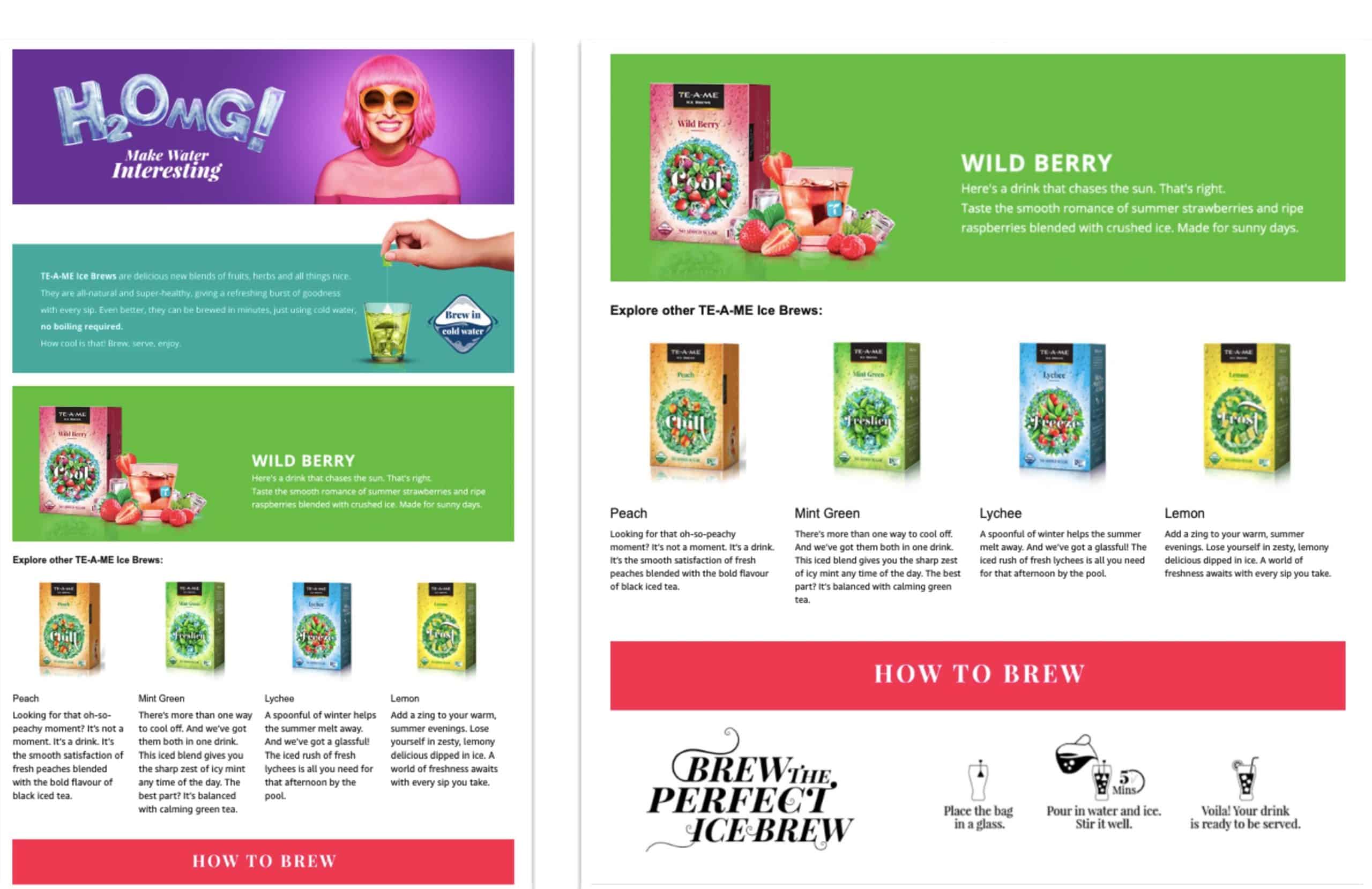
Google knows what we’re looking for, Facebook knows what we like, but Amazon knows what and how we buy. In addition, Amazon is pursuing a customer-oriented platform with the marketplace business, which makes customers happy and leads to more usage. This means that more and more companies are flocking to the platform in order to place products in relevant target groups.
Anyone who wants to be successful on the platform should understand far more than search engine optimization. The diversity and thus the complexity of the marketplace grows every day. Amazon marketing offers content, advertising and price promotions and all areas are intertwined. This article gives you an all-round look at marketing on Amazon and more details on the individual sub-areas.
Which areas belong to Amazon Marketing?
In order to get closer to the individual areas of Amazon Marketing, the first step is to have an overview of all core elements:
1. Sales models
2. SEO content
3. Brand content (A +)
4. Brand store
5. Price promotions
6. Performance advertising
7. Display advertising
1. Amazon’s sales models: Seller, Vendor and VenSel
Let’s start with the most important decision of any company on Amazon, the choice of seller model. With the choice you are laying an elementary foundation for your marketing strategy on Amazon. Basically, there are the seller and vendor models. Both terms are often incorrectly grouped under the term “Marketplace”. Even the simple distinction between retailer and manufacturer has long been no longer possible. The easiest way for you to remember you: sellers sell on and vendors on Amazon .
The seller sells on Amazon, the products are sold independently, marketing is self-controlled prices are self-designed, customer communication and logistics (including returns) are taken care of independently except for the products with Amazon service “Fulfillment by Amazon” (FBA).
The vendor sells to Amazon, meaning the company has an annual contract with Amazon and sells the products directly to the online retailer for the amount of the sales prices specified in the contract. Depending on the size and importance of the company and negotiating skills, the terms differ. In return, Amazon takes over the entire logistics, customer communication and pricing. However, the vendor continues to do the marketing himself.
So sellers have greater freedom compared to the vendor , but in return they also have a higher administrative burden. In the same context, both have controlling the marketing themselves.
However, for the core areas of Amazon marketing, the seller models now differ little. A notable difference is, for example, A + Premium, which is described in the article’s course in the Brand Content area and is currently intended only for vendors.
The hybrid model VenSel is becoming more and more established as the third model. Here, the advantages of both models are used to achieve the best possible result on Amazon. The hybrid model requires a very high administrative effort and good know-how in Amazon marketing and is considered the supreme discipline.
2. Search Engine Optimization (SEO) content
SEO content means texts that are specially optimized for the search behavior of customers – in the best case especially for a search engine – so that with Amazon, the products are found, accessed and ultimately also bought more frequently. When optimizing content, it is important to align the detail page of a product, the so-called product detail page, to Amazon’s A9 algorithm .
To increase the findability, it is first necessary to clarify which areas of a product detail page actually play a role in marketing for the A9 algorithm from Amazon. In the Amazon SEO area, we differentiate the product detail page into title, bullet points, backend and product description. The first three areas are very important.
The title is clearly visible in the search results, thus significantly influencing the click-through rate (CTR), i.e. the probability of how often your product is clicked on.
The bullet points are used to describe the most important facts, properties and uses of the product and enable you to differentiate your product from the competition.
The backend offers the advantage of using special spellings and misspellings of your target group and thus drawing their attention to your portfolio.

You should make the best potential use of these areas in the SEO area of Amazon marketing in order to replace the physical sales experience of your customers as much as possible. So means the quality of your products with the help of creative brainstorming – the seven W-questions are very good for this – as well as making good branding an emotional experience for the customer. Your product range has to be right, because nobody buys a product, not even analog, that is incorrectly described and becomes implausible.
It is crucial that your focus in SEO is on titles, bullet points and backend and that you use them with a wide variety of synonyms. Good keyword research is therefore the be-all and end-all here.
Although the product description can be relevant for indexing on Amazon, it plays a subordinate role compared to the other three areas. In addition, the product description is hidden from sellers as soon as A + content is available. At Google, the product description plays an important role.
Good SEO texts improve the description of a product and increase its findability. Both factors lead to more sales and more revenue. This increases the organic ranking of the product, which again leads to increased visibility and gives you an advantage over your competitors. Textual search engine optimization is a fundamental pillar for your success on Amazon.
3. Brand Content: A + and A + Premium
In contrast to SEO, brand content primarily plays an aesthetic and explanatory role in Amazon marketing for brand owners. The brand content, also called brand content, lives particularly from media elements and can be found in the lower area of a product page. Amazon Brand Content means A + or A + Premium. You can only use these marketing tools to your advantage if you are a brand manufacturer and have carried out your brand registration via the Amazon Brand Registry .
At A + is a free feature on the product detail page, which sellers and vendors allow the brand and special features of a product to highlight. Thus, with A + you can stand out from your competitors and your conversion rate optimizes.
On an A + page you have enough space for additional descriptions, quotes, additional images and icons and informative charts such as product comparison tables that encourage customers to buy. You can incorporate A + content into your marketing strategy and draw the attention of your customers specifically by cross-selling to other products and up-selling to more expensive products.
A + is becoming more and more important in Amazon marketing for brands and manufacturers. Something related this to the increasing use of Amazon as a product search engine and to the increasing number of customers who flock to the marketplace via mobile devices. The bullet points on smartphones and tablets are increasingly playing a subordinate role, as the screens are much smaller than the desktop which is why Amazon is focusing on visual product presentations. They sometimes show bullet points under the A + and usually cut off.
In addition, a good A + also has a positive effect on the organic ranking and thus the findability. Because a good A + leads to an increased purchase probability, increases the conversion rate and Amazon rewards this with a better organic ranking.
In addition, your A + content should also have good keyword research regarding search behavior on Google. Because it indexed the text relevant for Google and can have a positive influence on your performance on Amazon.
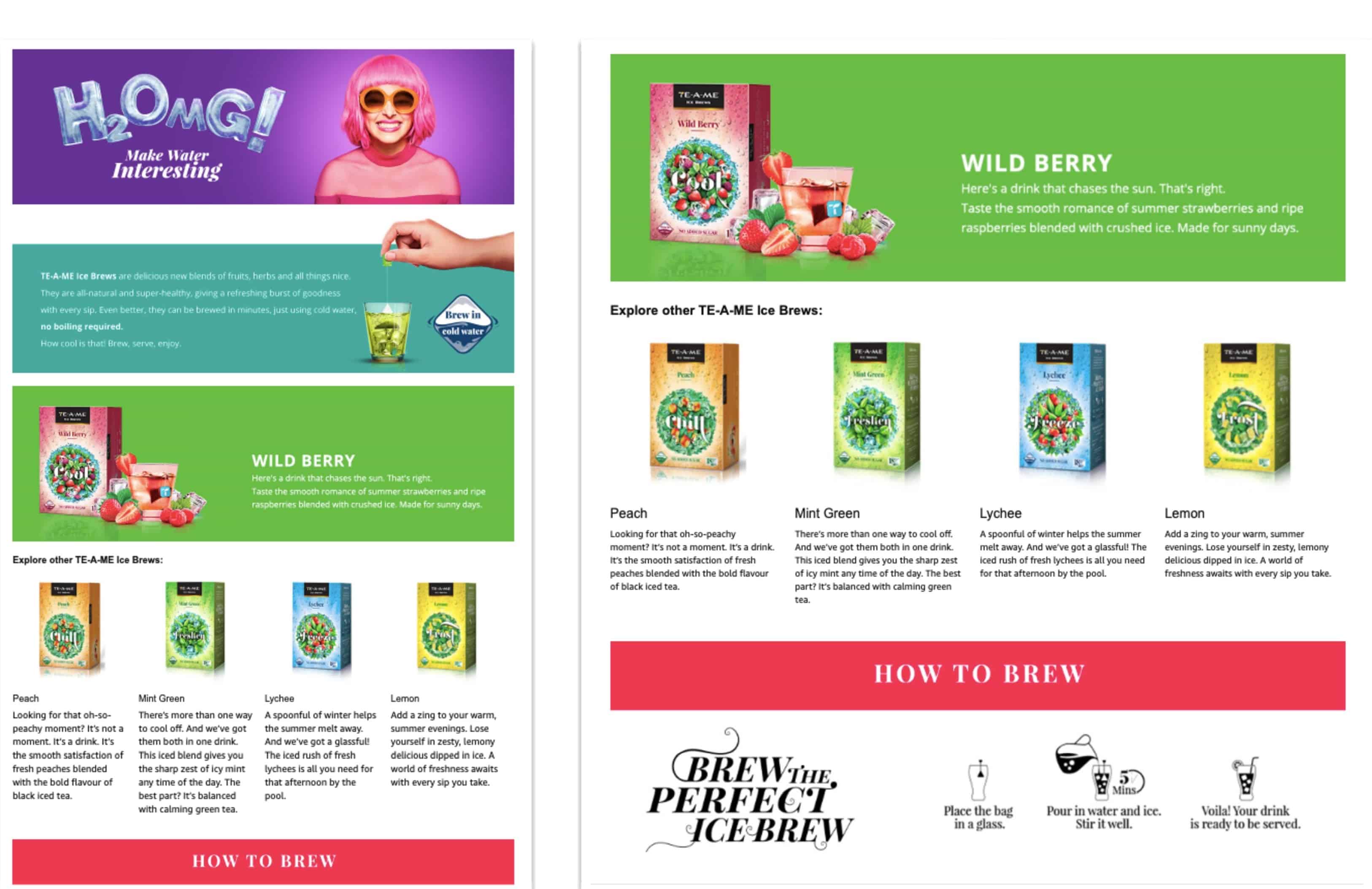
By the way, Amazon used to differentiate between A + (Vendor) and Enhanced Brand Content or EBC in terms of both names and functions (Seller). In the meantime, however, the US giant has standardized this designation to A +.
A marketing tool that is only reserved for vendors is A + Premium Content. Its structure offers more aesthetic and functional options to make the brand even more tangible for your customers. Particularly noteworthy are the modules Premium Full Video, Premium Hotspots and Premium Comparison. In contrast to normal A +, however, the tool is chargeable, whereby you as the vendor have to agree on the price tag with Amazon within your annual negotiations.
They created both A + and A + Premium according to a modular system and make it possible to present your products individually in order to create a positive buying experience and to strengthen the trust of your customers. You should pay attention to a common thread in your A + content, which ideally runs through your entire portfolio in order to guarantee the recognition value with your customers.
4. Brand Store: Your own shop on Amazon
The Brand Store is like the free website on Amazon and can be viewed as a separate web shop. Here Amazon offers you far more individuality to optimally present your brand and products. As with A +, be a brand manufacturer and carry out the brand registration via the Amazon Brand Registry. The brand store is also called a brand shop or shop-in-shop .
The strongest argument in favor of a brand store is that you decide what it should display within your brand store or brand shop. Your competitors have to stay outside , as Amazon doesn’t offer any space for advertising opportunities there . You create your completely own brand world, just on Amazon. In addition, a good brand shop increases the sales potential. You can see what such a start page can look like in the figure below using the example of Ritter Sport.
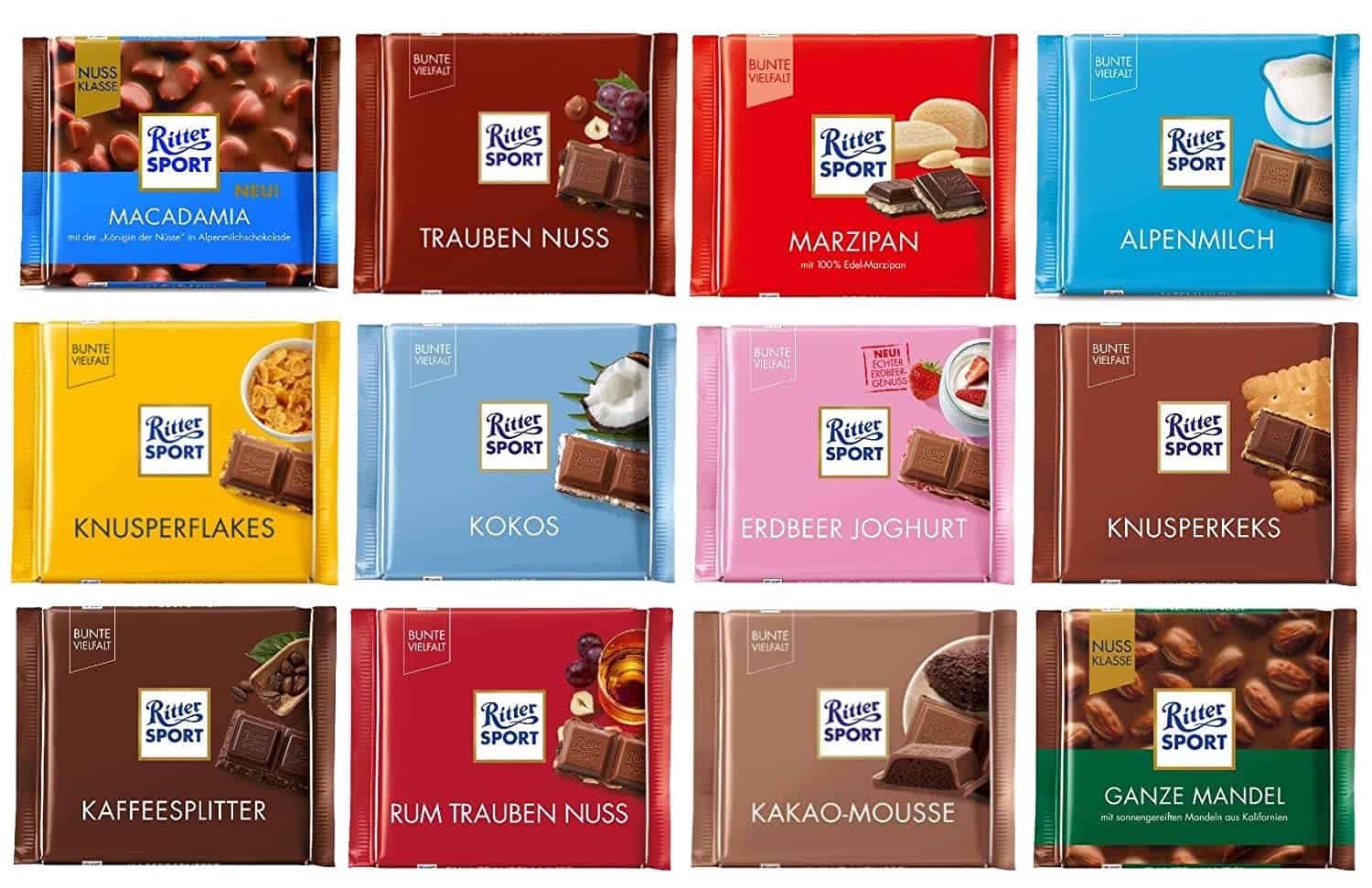
A well-structured brand store not only captures the brand world but also directs the customer specifically to complementary or more expensive products. It is particularly about optimizing the conversion rate and increasing the shopping cart. With the help of well thought-out pages and targeted up- and cross-selling, you can increase the shopping cart value and the number of units sold per order without the influence of your competitors.
Especially in connection with Sponsored Brand Ads (SBA) advertising campaigns, the Brand Store can contribute to profitability with a better cost-sales ratio. By clicking on the brand logo in the sponsored brand ad, the customer can be forwarded directly to a specifically defined page. You can decide for yourself whether directly on the start page or a category or sub-page. You can find more about sponsored brand ads and other advertising terms in performance advertising.
However, a brand shop can not only look good, it also has a lot under the hood. With the help of Brand Store Analytics you can get insights into the behavior of your store visitors in order to optimize your brand shop even better. For example, you can analyze your top pages according to sales, units and orders in specially defined time periods and derive measures for you and your brand.
A brand store is not only suitable for Amazon itself, but can also an ideal link between on page and off-page. You can use your brand store as a landing page for external traffic. Basically, you use your customers’ familiarity with Amazon to direct high-conversion campaigns from, for example, Google, Facebook or Instagram directly to the store. With the help of source tags, you can create specific links and precisely evaluate external traffic in Brand Store Analytics.
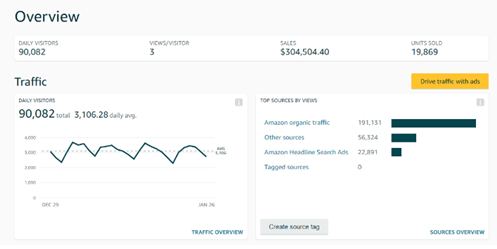
5. Price promotions: discounts and price reductions
When people talk about promotions in the Amazon world, most people think of performance marketing, for example bidding on certain keywords. However, Amazon also offers marketing instruments to encourage customers to buy a product through price measures and free products. It particularly recommended these marketing instruments for acquiring new customers.
The first options for discount campaigns are the 7-day offer (with vendors special offer for 14 days) and the lightning offer, also known as the Lightning Deal. Both serve the time-limited price reduction and appear on the Amazon page offers, but differ in the duration, which is specified by Amazon. A lightning offer is usually active between 4 to 12 hours, which can vary depending on the marketplace. Both options are good for pushing sales, especially sell-offs to reduce inventory.

As a further price measure, you can use the price reduction for both individual and volume discounts. This is a price reduction that can be valid for up to 365 days, which is illustrated to the customer by a price cut. The customer clearly sees how much money he would save by buying the product.
Amazon still offers sellers the option to use the exclusive Prime discount. As the name suggests, this is a discount campaign that only applies to Prime members and also shows a strike price and the savings in the search results and on the product page.
While they displayed the individual discount as a strike price with “Instead” and “Now”, the volume discounts are displayed to the customer between price and bullet points in the “Current Offers” area. For example, with the price measure, your customer can receive a discount of 10% if it purchased four or five units of the same product.
Besides the discount, it is also the price action one Buy and a free product got by which they put the customer when buying a product or a certain number of products a free product your choice to the cart. This is basically comparable Amazon specially classified to the price reduction in volume discounts. This option is also great for customer acquisition.
Last but not least, we should mention the Amazon savings subscription. A price measure that is suitable for Fast Moving Consumer Goods (FMCG). So for products that are bought again within short to medium intervals. We can find such products in the grocery, household and drugstore categories, for example.
As a seller and vendor, it can release products for the subscription area, whereby Amazon customers can receive a discount of up to 15% on regular deliveries of a product. You finance the discount and thus reward the loyalty of your customers with repeat purchases. The Amazon savings subscription can be a great marketing tool to increase your customer loyalty in the long term.
Customers who want to set up a savings subscription can set standard deliveries at intervals of 2 weeks to 6 months. An advantage for sellers is that they can deactivate the subscriptions while for vendors it can also be a mandatory part of the annual negotiations.
6. Performance advertising (PPC, CPC or AMS)
Amazon Performance Advertising , often also called PPC (Pay-Per-Click), represents the third advertising pillar in Amazon Marketing alongside the Demand Side Platform (DSP) and the Amazon Media Group (AMG) Reach, Amazon PPC is the performance-oriented solution , which mainly includes advertising campaigns with the bidding of keywords .
The enormous advantage that you can achieve with the help of Amazon PPC is the artificial increase in the visibility of your products. For example, while your product appears organically on page 10 of the search results, with the help of Amazon PPC and the right strategy they can list directly you in the first place on page 1.
You should definitely pay attention to the retail readiness of your products. So both on the quality and quantity of the reviews, the SEO and brand content, the stock availability and product images and the shopping cart field (buy box). You will advertise a product much better and more cost-effectively if your product is “retail ready”.
A value coined by Amazon, which shows the cost of sales and thus the efficiency of your advertising, is the key figure Advertising Cost of Sales (ACoS). The ACoS describes the ratio of advertising costs to the sales achieved. The smaller this value, the better the efficiency. The focus for the optimization of advertising campaigns is often set on this value and is calculated: ACoS = advertising costs / advertising sales.
Wish-list: The 5 most important key figures besides ACoS in Amazon Performance Advertising explained
RoAS
stands for Return on Advertising Spend and comprises the profit achieved per advertising spend in euros.
CTR
stands for describes the number of clicks on an advertisement in relation to the total impressions.
PPC
Pay-Per-Click is a classic payment method in which the advertising company pays for each click on an advertisement.
CPC
Cost-Per-Click describes the costs that the advertising company pays per click on an advertisement.AMS
Stands for Amazon Marketing Services and is a common synonym for Amazon Advertising. The term is no longer actively used by Amazon.
In Amazon PPC marketing, they made 4 different advertising media available: Sponsored Product Ad s (SPA), Sponsored Brand Ad s (SBA), Sponsored Brand Video Ad s (SBV) and Sponsored Display Ad s (SDA). Each advertising format has its own characteristics and should therefore be selected according to your own product strategy.
It natively integrated all formats into the Amazon page in the search results or on product pages. Keywords, ASINs or categories can therefore be selected as targeting, bidding on them in actual time and selecting the advertisers from Amazon in the auction process.
The auction procedure is the second price auction known from eBay, in which the highest bidder wins the bid, but only pays 1 cent more than the second highest bid. So if you are ready to pay a maximum click price of EUR 4.00 and the bidder at the second-highest bidder offers EUR 3.50, then you would pay EUR 3.51.
It is important to say that Amazon’s performance marketing is based on Cost-Per-Click (CPC), which means that you only pay as soon as a potential customer clicks on your ad . By the way, CPC is also a frequently used synonym for Amazon Performance Advertising, as is AMS (Amazon Marketing Services). In addition, each time you click on your ad, adding your product to the shopping cart and finally purchasing the advertised product, the ranking of your keywords and thus the visibility of your products increases sustainably.
We come to the first and probably the most frequently used advertising medium, the Sponsored Product Ad (SPA). Amazon gives the SPA most of the advertising space on the platform and it is also very profitable. At first glance, the SPA can look like an organic search result, but it is marked with “Sponsored” in the search results.
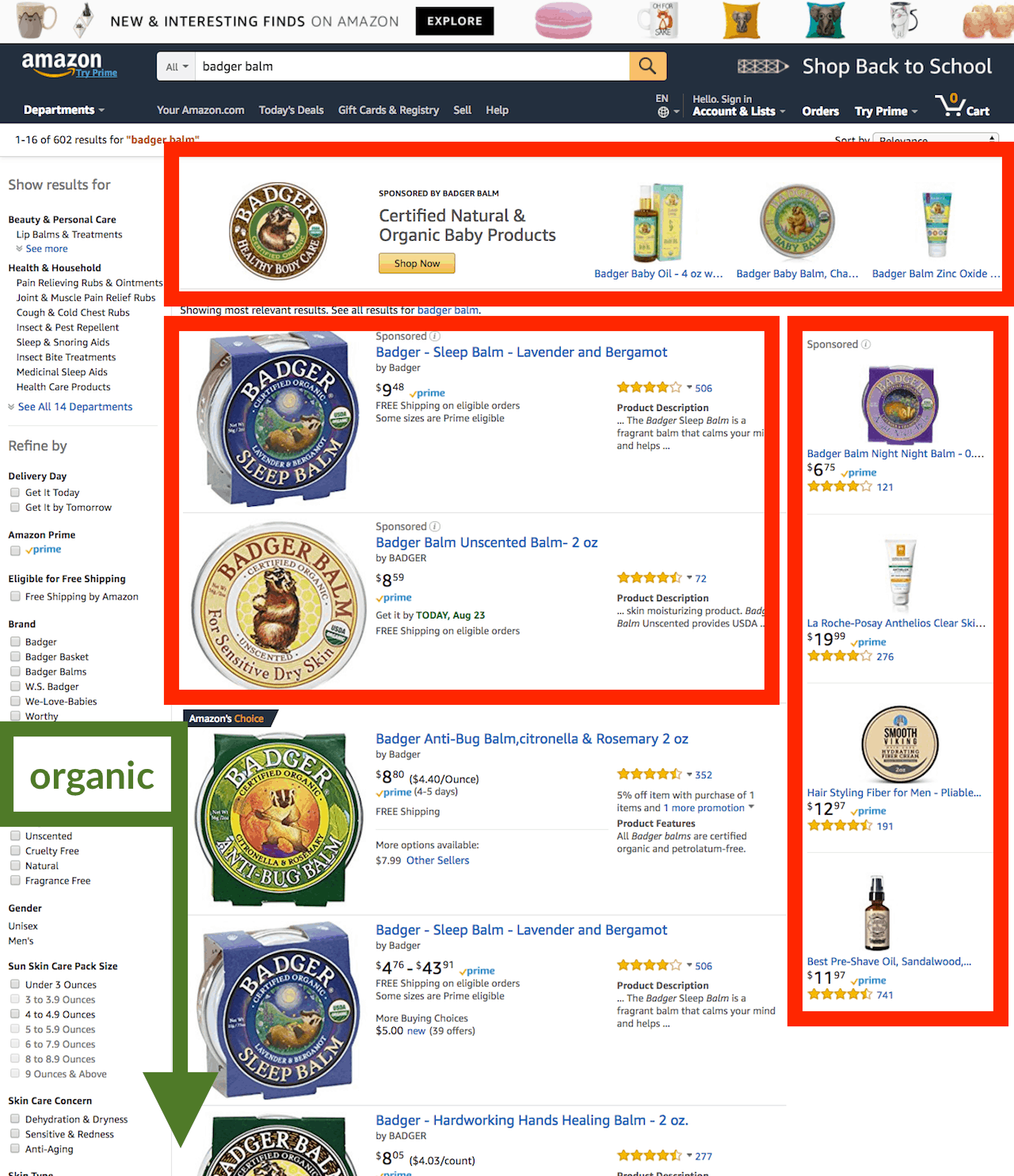
The SPA do you think about, between and below the organic search results. In addition, they can find the advertising format on the product detail pages, for example under the bullet points, the shopping cart field (buy box) or in the recommendations area. If a customer clicks on a SPA, it will direct them to the product detail page of the advertised item. Any other link, such as to the brand store, is not possible.
Someone mainly based the optimization of Sponsored Product Ads on the cost-sales ratio, instead, as the SPA is the ACOS / ROAS of absolute revenue driver. A low to medium-sized advertising budget is sufficient for SPAs, as we are in the lower funnel of the customer journey.
Sponsored Brand Ads (SBA) represent the banner advertising in sponsored marketing and are suitable for branding and awareness because of the placement directly below the search input. SBAs can also be found up to two times to the left and up to four times under the organic search results. As a brand manufacturer, you can only activate an SBA if you have registered the brand via the Amazon Brand Registry.
With the advertising format, you can display a maximum of three products, your brand logo and an advertising slogan in the search results. This advertising material links either to your own brand store or an automatically created landing page with the products shown, on which you can optionally display even more products.
As with SPAs, SBAs also use keywords as targeting. In addition, you can now also place the SBA specifically on product detail pages, provided they set the brand store as a landing page. This is ideal for cross- and up-selling .
Besides keywords, you can also place an SBA in product categories and directly on ASINs. In the product categories, you can display the advertising format not only in the main but also in the sub-categories.
It mainly based the optimization of Sponsored Ads fire on the impressions and click-through rate or CTR place since the SBA focuses on visibility and awareness. Depending on the strategy and connection, the ACoS / RoAS can also play a decisive role. For SBAs, have a medium to high advertising budget ready, as we are more in the upper funnel of the customer journey.
Besides the normal Sponsored Brand Ad, there is now also the Sponsored Brand Video Ad (SBV) for brand owners. We can view the SBV as an extension in Amazon marketing and focus even more on branding and awareness, but only in connection with a video. Here, the customer’s attention is guaranteed to the maximum. Depending on the marketplace, the advertising format currently appears above, in the middle or below the organic search results .
Similar to the SBA, sponsored it optimized primarily brand video ads because of impressions and click-through rates. The ACoS / RoAS should play a minor role. The advertising budget should be set high here, as the click prices are relatively high and the number of advertising spaces is low.
The fourth and last advertising measure are Sponsored Display Ads (SDA). The SDA you find on page on product detail pages, is under the cart Field (Buybox), under the bullet points, the right of the reviews, the customers’ questions (mobile) and in the shopping cart field (Buybox). In addition, it displayed the ads off- page on third-party websites. SDAs are creatively customizable. For example, the brand logo and headline can be used.
The advertising format is mainly to be found where the customer is deep in the customer journey, i.e. shortly before the purchase. Therefore, these ads can help to deter your customers from buying the competing product and to draw them to your own products. Therefore, ASINs, categories and prospects (Amazon customers who have shown interest in similar categories) serve as targeting.
It is also possible to use remarketing or re-targeting using SDAs. To reach people with an advertisement who viewed your products but have not yet bought them. The enormous advantage is that these ads can also be displayed not only on Amazon, but also off-page on external websites .
It optimized primarily sponsored Display Ads based on the ACoS/RoAS. However, it should be noted that with this advertising medium you are in the display area, which is why ACoS/RoAS are usually higher.
7. Display Advertising: Advertising with Amazon’s user data
With the Amazon Demand Side Platform (DSP), the US group offers a marketing solution for purchasing banner advertising space programmatically on and outside of Amazon. We can see the DSP as a counterpart to the Google Display Network (GDN). While in performance marketing the focus is primarily on the search behavior of customers, the DSP focuses on the person and categorizes them into target groups based on different behavioral patterns.
For example, Amazon can use search and purchase behavior and preferences for series and films (through Amazon Prime Video) to determine whether a person is a coffee lover, interested in energy efficiency products or an Audi driver. And you can access precisely this interest-based data with the Amazon DSP.
While classic targeting such as demographics and context are nothing special today, the behavior-oriented target groups (audiences) are extremely interesting. Here Amazon offers the two special target segments Lifestyle and In-Market. The peculiarity results from the data that Amazon has from users and buyers.
With the help of the analysis of the search and purchase behavior of customers, Amazon assigns them to a lifestyle audience (interest-based) such as coffee or cat lovers. Via In-Market you can address users who have been active in a category such as camera and photo in the last few days and therefore could have a higher purchase intention.
List: Overview of the categories for segments of the DSP
In-Market: Amazon users who
have searched in the respective category in the last 30 days
Lifestyle are interest-based and reflect the phases of life and the characteristics of the Amazon users.
Context means the targeted display of advertisements on external websites that match certain topics.
The targeting is demographic based on, for example, the age and gender of the Amazon users.
Geographical and temporal include both the local limitation based on the place of residence or whereabouts of the Amazon users and the time limitation of the advertising display, for example only between 7:00 p.m. and 9:00 p.m.
Technology & Domains means the limitation of users based on devices (desktop, smartphone, etc.), software (Windows, iOS, Android, etc.) and websites.
Overlap is a function that enables new target groups to be used based on an overlap with existing Amazon segments
Besides Amazon’s usage data (First Party Data), you can also use your company’s own target groups. For example, your company can use third-party data as your own CRM data. You can also implement traffic pixels on your website or web shop and enrich your campaign with this data.
In contrast to performance advertising, billing does not take place when the customer clicks (CPC), but when they have seen the advertising banner. The well-known principle of cost-per-mille (CPC) or price per thousand contact (TKP) applies here. In addition, the DSP console is much more complex and only available to a limited extent. You only get access to Amazon data if you book a campaign via Amazon (managed service) or agencies in self-service. Individual access is only possible in connection with the contractual commitment of a high annual advertising budget.
The DSP offers excellent advertising measures for growth and acquisition of market share. There are basically two directions of awareness and remarketing, with which you can take new customer acquisition to the next level. Both orientations consider different goals, targeting, and budget levels.
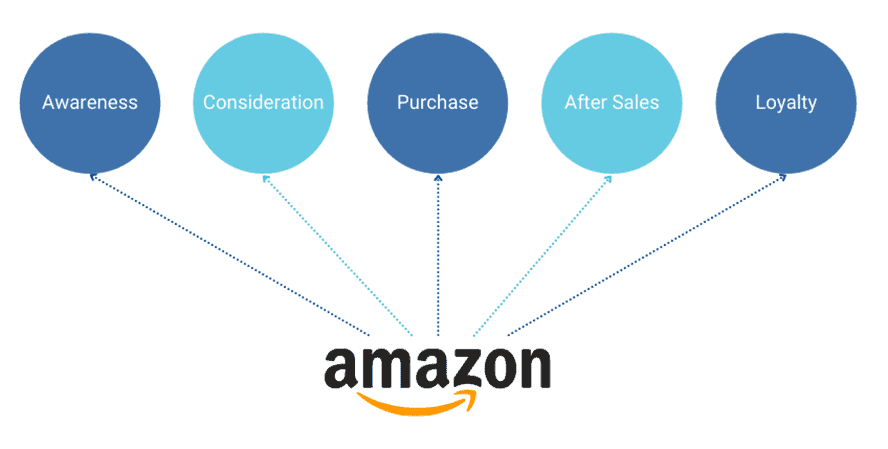
Awareness campaigns primarily increase brand awareness and start early in the customer journey. Above all, we address here potential new customers who have not yet had any measurable contact with your brand. The aim is to direct the branding and the attention of the users to them and thus sustainably increase the demand. A manufacturer of cat food could, for example, use the lifestyle segment “cat lovers” in connection with the in-market segment “cat food” in order to play a video spot for this audience and thus win new customers.
In awareness, more budget (at least EUR 5,000 per month) should be planned, since the users should be addressed several times and wastage should be planned. In addition, the focus is completely on the key figures impression, cost-per-mille (CPM), click-through rate (CTR) and, with a video spot, on video completion rate (VCR). The more users have seen a commercial, the more impressions it gets. CPM describes how much money it cost on average to reach 1,000 users with an ad. The CTR describes the percentage of users who clicked on the ad. And the VCR describes what percentage of the users who saw the commercial also watched it to the end.
The remarketing, also known as re-targeting, can with a smaller budget to be scheduled (per month from 1.000 EUR per product). Here they address users who have a measurable interest in your products, your category or competing products. Re-targeting is very performance-driven, i.e. the focus is on sales, sales and ROAS (cost-sales -relation).
Classic re-targeting means the display of advertisements to potential buyers who deal measurably with your products and your brand, but have not yet bought a product or should buy it again. With the latter, existing customers can develop long-term loyalty to your brand.
A special feature that other demand side platforms do not allow is the use of re-targeting on competing products. You can use the Amazon DSP to reach potential buyers who have viewed and / or bought specific competing products. A refrigerator manufacturer can therefore target its own refrigerator to a target group that has looked at a similar refrigerator from a competitor and is gaining market share in a targeted manner .
Re-targeting also works with classic banners, with Amazon attracting visitors with the Dynamic E-Commerce Ad (DEA), an Amazon-exclusive advertising format. A DEA has a modular structure, contains various components of a product detail page (price, image, title, etc.) and outputs them in a wide variety of formats. The Amazon algorithm itself controls and optimizes how the components are assembled regarding the set target KPI.

